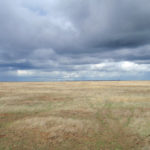NATURAL STEPPE ECOSYSTEMS AND WHAT THEY TRULY ARE
Abaturov B.D., Molchanova L.V. Natural Steppe Ecosystems and What They Truly Are // Ecosystems: ecology and dynamics. 2020. Vol. 4. No. 2. P. 26-45. | Abstract | PDF | Reference |
- Evidence of saiga’s winter grazing in Kalmyk steppe, “Chyornye Zemli” State Nature Reserve, November 30th, 2006 (photo by B.D.Abaturov)
- Stocktaking of fodder resources on saiga’s pastures, “Chyornye Zemli” State Nature Reserve, November 30th, 2006 (photo by B.D.Abaturov)
- Winter field camp in Kalmyk steppe, November 30th, 2006 (photo by B.D.Abaturov)
- Blooming steppe in spring, Rostov Biospheric Nature Reserve, April 12th, 2016 (photo by B.D.Abaturov)
- Colubrid in a spring steppe, Rostov Biospheric Nature Reserve, April 12th, 2016 (photo by B.D.Abaturov)
- Fairy ring in a steppe of northern Caspian Region, Dzhanybek, May 4th, 2010 (photo by B.D.Abaturov)
- Shepherd’s blind for rest and protection from wind during the grazing, Dzhanybek, May 4th, 2010 (photo by B.D.Abaturov)
- Natural vegetation recovering after steppe fires, Dzhanybek, May 4th, 2010 (photo by B.D.Abaturov)
- Autumn phase of a steppe pasture, the spherical plants are Ctratocarpus arenarius, Dzhanybek, September 18th, 2013 (photo by B.D.Abaturov)
- Dry steppe (semi-desert), autumn phase, Dzhanybek, September 21st, 2013 (photo by B.D.Abaturov)
- Steppe pasture in autumn, Dzhanybek, October 2nd, 2011 (photo by B.D.Abaturov)
- State boundaries across the steppe, Volgograd and Western Kazakhstan Regions, October 2ns, 2011 (photo by B.D.Abaturov)
Steppe ecosystems have suffered through major transformations, caused by long-term cattle grazing and ubiquitous land plowing, and now they lack life-supporting functions. Preservation and restoration of ecosystems the way they naturally are have become our main goals. It may seem that cease or restriction of grazing and plowing should make the natural condition of steppes restore. However, it is still unclear how much the natural ecosystems differ from the anthropogenically transformed ones, and what their functionality mechanics truly are. The types of animals’ impact that have formed in the nature without any connection to human’s activities (such as wild ungulates grazing, soil digging by steppe fossorials) are similar to such anthropogenic factors as cattle grazing and land plowing, to a certain extent. Grazing in steppe natural zones has always been a natural factor, playing its required role in ecosystems. In the natural conditions the activities similar to plowing are the mechanical soil processing carried out by numerous large and small animals living in the ground. All these types of vegetation and soil transformation are not a random phenomenon, but a regular one, and it spreads throughout the entire steppe zone, inhabited by animals. This phenomenon is similar to the anthropogenic impact in itself. Nature protection measures, aiming to restore natural ecosystems, must take into account the necessity to preserve these natural dynamic processes. Without these processes, the specific features of steppe ecosystems functionality inevitably disappear, followed by negative aftermaths and nature degradation.
Keywords: natural ecosystems preservation, anthropogenic and natural forms of functioning, land plowing, land digging caused by animals, cattle grazing, wild mammals grazing, natural ecosystems degradation.
DOI: 10.24411/2542-2006-2020-10058














